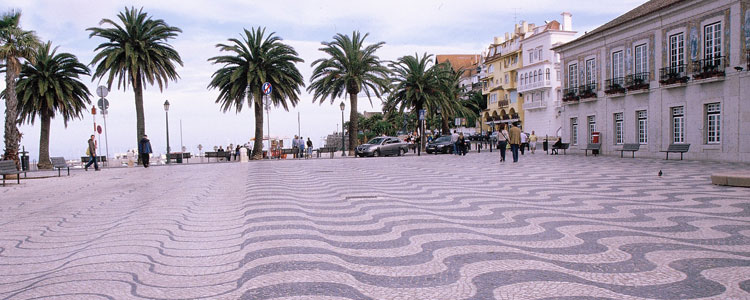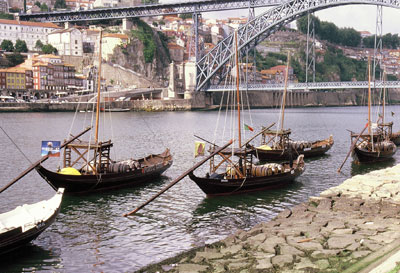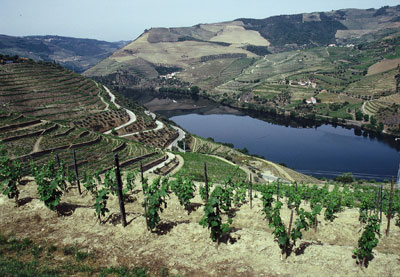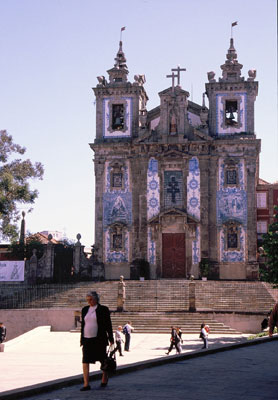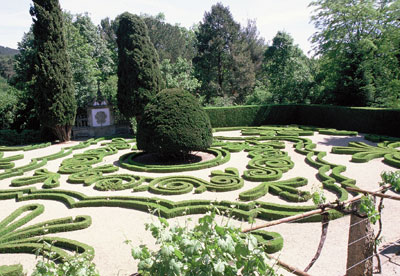Cruising Portugal’s Douro River
by Walt Huse, Fort Myers, FL
A cruise on the Douro River, in the heart of Portugal’s port wine district, offers visitors many opportunities to taste both red and white port wine as well as explore several historic places.
Lisbon
In mid May ’09, my wife, Dorothy, and I left for Lisbon, where we were met by a Uniworld representative and taken to our hotel. We would spend two days in Lisbon before boarding our ship.
Since we arrived early in the day, we decided to visit the Gulbenkian Museum (Av. de Berna 45A). Our host/guide gave us a map and walking directions with the warning that we’d find no signs with street names and few, if any, directional signs.
“It’s a cultural thing, I think.” she said, adding that if we got lost to not hesitate to ask for help, as most people speak some English.
So off we went — and did we ever get lost! We had to ask three people for help, but we finally found the museum and it was worthwhile.
After our initial walking experience, we decided to take a taxi back to the hotel.
The next day we had the usual city tour, providing more information than we could assimilate. Old Town was very interesting, with its narrow streets and the numerous little shops each handling just one item — only fish, only meat, only snails — and operated by just one person.
Many of the buildings were in very poor condition, and we wondered why restoration hadn’t been done to preserve them. There was a simple answer: rent control established in the 1940s limited the amount of rent that owners could charge, many apartments renting for as little as five or 10 euros per month, so owners could not afford repairs and maintenance. We were told, however, that this is about to change.
Later we visited the waterfront park, where the famous Belém Tower is located, and the nearby Monument to the Discoveries, honoring all of those who set sail from Portugal during the Age of Exploration.
Also nearby is the seaplane used to make the first flight from Lisbon to Rio de Janeiro in the 1920s.
Our next stop was at the National Coach Museum, which houses many royal coaches. Probably the most unusual we saw was the one with a built-in privy!
Sintra side trip
That afternoon we visited Sintra, at one time occupied by the Moors, who built a hilltop castle there. The castle was later converted to a summer retreat for the royal family.
A unique feature of the building is that most of its walls are decorated with tiles arranged in beautiful patterns, each room done differently.
The ceilings are equally unusual. For example, in the Council Room the ceiling is painted with more than 70 stags, each holding a coat of arms of a noble family. In the 16th-century chapel, the ceiling is made of chestnut and oak and the floor is mosaic tile.
After a full day of touring Lisbon and Sintra, we were very glad we had worn good walking shoes. In every community we visited, the sidewalks and roads were cobblestone and not always in good repair. High heels, loafers or flip-flops would have been hazardous.
Coimbra
On our way the next day from Lisbon to Porto to board our ship, we stopped at Coimbra for lunch and a visit to its university, one of the oldest in Europe. While in the city, we noticed a number of college-aged people walking in groups, all wearing huge black capes. The capes are a part of the university “uniform” and have been worn for many years.
Someone commented that the students looked like “Harry Potter” characters. Apparently, J.K. Rowling, author of the “Harry Potter” series, lived in the area (Porto) for many years.
On the university campus, the Biblioteca Joanina has more than 250,000 rare books, some dating from the 12th century. Researchers are able to use these resources, with permission, in small rooms hidden behind the shelves.
One of the problems with having so many old books is insects. Here there is a unique method of insect control: bats. After the library closes for the night, small bats come out to eat the bugs.
Next to the library is the Royal Chapel, dedicated to St. Michael. Inside, the walls are covered in decorative tiles that date to 1613, as does the altar.
The chapel organ is one of the largest in Europe — so large that a wall had to be removed to install it, and the organist must enter from the adjacent building. Decorated with Chinese motifs, similar to those on the shelves in the library, the organ dates to 1733 and has 3,000 pipes.
Porto
After we arrived in Porto, boarded the 126-passenger Douro Queen and unpacked, we walked along the city’s waterfront. At one end were several signs listing the wineries in the area. Much to our surprise, there was a Taylor winery listed. We have consumed Taylor port for many years and thought it was a New York wine.
Porto is the second-largest city in Portugal. Along the waterfront we noticed a number of very narrow houses, some only one room wide, with no spaces between houses. Why so narrow? Because taxes were based on the width of each house’s façade, as in many old cities in Europe.
On our city tour the next day, we learned that Porto is built on a very steep hill, with the business/shopping area at the top. To get from the waterfront to the business area you can take the bus or the funicular or climb the steep hill.
Later we visited the cathedral, which was undergoing major reconstruction.
In most cathedrals we’ve visited, there usually are some original windows or the remnants of them. Not so in Porto! All the windows are replacements, some installed as recently as the late 20th century.
Enjoying local wine
During the next few days of cruising the Douro, we visited several wineries and had tastings at each. Basically, there are five kinds of port. Ruby is aged in 73,000- to 75,000-liter oak vats for at least two years. Tawny is aged in oak barrels about the size of 55-gallon drums for two to seven years.
Late-bottled vintages are made from very select grapes of a single year. After being aged for five years in wooden casks, they are bottled and are ready for immediate drinking.
Vintage port is made from the finest grapes of a single year (not all years qualify). It is aged for two years in barrels, then bottled and kept for another 10 or more years. These should be consumed within 24 hours of opening.
Finally, there is a white port, which we didn’t care for.
Getting to the wineries was quite an experience since they were at the tops of hills or mountains above the vineyards. In just about every case, we were driven by bus up a narrow one-lane dirt road with innumerable switchbacks, no guard rails and a drop of several hundred feet. At times, I know the front end of the bus was over the edge of the mountain while navigating the turns.
At each tasting, we had samples of ruby, tawny and white port and were given an opportunity to purchase wine and other wine-based products.
The changing landscape
As we cruised along, the scenery gradually changed from cities to small towns to wooded areas and then vineyards. In spots, all that was visible along the shore was hill after hill of grapevines, some growing parallel to the river, some perpendicularly.
Vines growing parallel to the river cause less soil erosion but are very labor intensive; those growing perpendicularly are easier to manage but cause some soil erosion. As a result, most vineyards do both types of plantings.
During the harvest season, the hills are alive with pickers, but in the spring and summer it is rare to see anyone in the vineyards.
We did visit one place noted for rosé wine: the Mateus Palace. For years I have purchased Mateus rosé, thinking it was a family-named winery. Now I know that mateus is a Portuguese title similar to “squire.”
Built for the last Count of Vila Real, the palace is still owned by the family and is used part of the year by them.
Built in the 1700s, the palace has, for the period, small, homey, comfortable rooms. In the entrance hall, the ceiling is beautifully carved chestnut. At the rear of the palace, the formal gardens are spectacular.
To Spain and back
The navigable portion of the Douro ended near the Spanish border, so we went to Salamanca, an old Spanish city noted for its huge plaza.
Salamanca was first settled by an indigenous tribe in pre-Roman times. In the third century, Hannibal destroyed the city, leaving only a first-century Roman bridge, now used as a pedestrian bridge which offers a grand view of the city.
Its central square, Plaza Mayor, was built in the 18th century for bullfights. Today, with a capacity of 20,000 people, it is used mainly for concerts.
While we were visiting Salamanca, our ship turned around for the journey back to Porto. Castelo Rodrigo and Lamego were the most interesting ports, to us, on our return voyage.
Castelo Rodrigo
Castelo Rodrigo, located about 3,200 feet above the Douro River, is one of Portugal’s 12 Historical Villages. First settled by the Celts, probably in the first century BC, the village was later developed by the Romans, who built a fortress of which there still are remnants.
Throughout the centuries, Castelo Rodrigo has been home to Jews, Christians and Arabs living peacefully together. Rua da Sinagoga (Synagogue Street) dates to the 16th century. Because there was no actual synagogue, services were held in homes.
In 1192, a church was founded to protect pilgrims on their way to Santiago de Compostela. On the left side of the altar, the Ten Commandments are painted on wood using Arabic numerals rather than Roman; the 14th-century tombs under the main aisle are also dated with Arabic numerals.
The village that exists today was built in the 15th or 16th century as a walled community. Although the official census lists 400 residents, there are only about 75 living there year-round; the remainder are seasonal.
Some of the houses were in shambles while others were in excellent shape, with small rose gardens at their entrances. The view of the surrounding countryside from just about anywhere in Castelo Rodrigo was really inspiring.
Lamego
Lamego, a small town south of the Douro, has had a cathedral since the sixth century. From the eighth to 10th centuries, Lamego was under the control of the Moors. By the mid 1100s Portugal had regained control.
Located between the Douro and Beiras rivers, the town was at one time a prosperous trade center. Today it is noted for one of Portugal’s most important pilgrimage sites, the Sanctuary of Our Lady of Remedies.
Main street is about three or four blocks long, with shops on both sides and a beautiful mall filled with multicolored pansies in the middle. At the end you can see the 686 steps leading to the sanctuary. Fortunately, our bus took us to the top of the hill so that we could enter the sanctuary from there.
The stairway is interspersed with landings decorated with tiles, fountains, urns, etc. No one in our group attempted to climb the steps, but several of the younger members did walk down. I walked down to the first terrace and found it very difficult because the steps were not a uniform height nor was there a usable handrail.
Built in the late 1700s on the site of a 14th-century chapel, the sanctuary has a commanding view of the town. Its interior is very ornate but not too large.
At the opposite end of the main street is the Bishop’s Palace, now a museum. Its collection is quite impressive for a town of probably no more than 20,000 to 30,000 people. I was most impressed with the three 17th-century chapels as heavily gilded as the abbey in Melk, Austria.
From Lamego we sailed back to Porto.
Summing up
While there were ample activities at ports along the Douro to keep everyone interested and busy, there also was plenty of time for relaxation between ports of call. The Douro Queen had a large sundeck with a small pool and hot tub as well as many lounge and deck chairs for sunbathing, reading, etc. With cooperative sunny weather, we all made good use of these facilities.
The scenery along both sides of the river and the many locks that were traversed kept many of the neophyte river cruisers busy. Food and accommodations on the Douro Queen were superior, in our opinion.
Based on our experience, we definitely recommend Uniworld (Los Angeles, CA; 800/733-7820). Prices for the 2010 sailings of the 12-day “Portugal, Spain & The Douro River Valley” cruise, exclusive of airfare, range from $2,949 to $3,699 per person, double, depending on departure date and cabin category.

